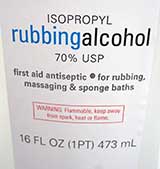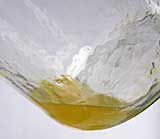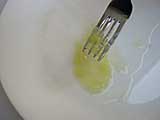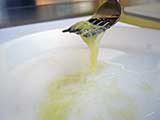Meats and Sausages
Pectin and Jelling Tests
Pectin test determines whether juice contains enough natural pectin to form a gel.
Jelmeter test
A jelmeter is a graduated glass tube with an opening at each end. It is used to determine the amount of pectin in fruit juice. The rate of flow of the juice through this tube is used as a measure of the jellying power of the juice. Therefore, it is an index to the amount of sugar to be used. Jelmeters were once commonly available, but are not easy to find today, most likely because the alcohol test is more reliable.
Alcohol test (extracted juice only)
Juice low in pectin will form small particles of jelly-like substance that is significantly weaker.
If the juice contains a little pectin, more can be added by:
- Adding juice from high pectin fruit, usually apples. This is usually done using a hot extraction method.
- Adding home prepared pectin from apples or citrus fruit.
- Adding commercial pectin (powdered or liquid). If the pectin test is satisfactory, the juice is mixed with sugar, cooked, and filled into jars. Upon cooling, the jelly will form.
Cooking Test (jellies only)
In a small pot combine 1/3 of juice and 1/4 cup of sugar. Heat slowly to dissolve sugar, then boil mixture rapidly until it satisfies the spoon test. Pour the jelly into a small jar and let cool. If the mixture gels, the fruit juice will produce jelly.
The cooking end point
Thermometer Test (jellies, jams, marmalades, preserves)
Insert candy thermometer into cooking jelly or jam and take the reading. The "done" temperature should be 8° F higher than the boiling water temperature at this elevation level. At sea level the "done" temperature will be 220° F, at higher altitudes the "done" temperature will be lower. For example in Denver, Colorado (5200 ft above sea level) water boils at a lower temperature so the "done" temperature is also lower.
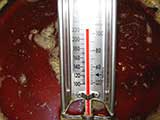
Thermometer test.
Spoon sheet test (jellies only)
Dip a cool metal spoon into the boiling mixture and raise it to eye level. This should take the spoon out of the steam. Turn the spoon to see how the syrup runs off the side. A beginner may take a few readings so it is best to remove the pan from heat to avoid overcooking the jelly. The syrup should form two drops that should join together and fall off slowly as one sheet at the bottom of the spoon. When this happens the syrup should contain the appropriate pectin and sugar combination.
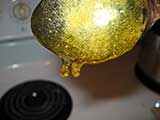
Spoon test.
Refrigerator test (jellies, jams, marmalades, preserves)
Place a small amount of boiling jelly on a cold metal plate. Put it into the freezer for a few minutes, then take it out. If the jelly gels, it is done. Remove the pan from the heat during the test to avoid overcooking the jelly.
Refractometer test (jellies, jams, marmalades, preserves)
It is necessary to cool the sample of jam or jelly to room temperature 68° F (20° C). A small portion of boiling jam is removed and placed in a suitable metal container which is closed and submerged in cool water. When the sample has cooled it is mixed thoroughly and smeared over the refractometer prism. Then the reading is taken. During that time the jam continues cooking so the sample reading should be performed relatively fast in order not to overcook the preserve. There are refractometers which will accept a hot sample of jam or jelly.
Test for Acid in Fruit Juice
This test relies on tasting a fruit juice and comparing the tartness of the juice to that of a sample.
The sample: a mixture of 1 teaspoon of lemon juice, 1/2 teaspoon of sugar and 3 Tablespoons of water. If the juice compares favorably with a sample, there is a sufficient amount of acid for a strong gel. If the juice is not as tart, add 1 Tablespoon of lemon juice (or 1/8 teaspoon citric acid) per cup of juice and repeat the test.
If the amount of pectin was unknown, or no recipe was available, the traditional recommendation was to add 1 cup of sugar to 1 cup of juice. This often resulted in an overly sweet product. The latest trend is to add 1 cup of sugar to 1 cup of juice.

